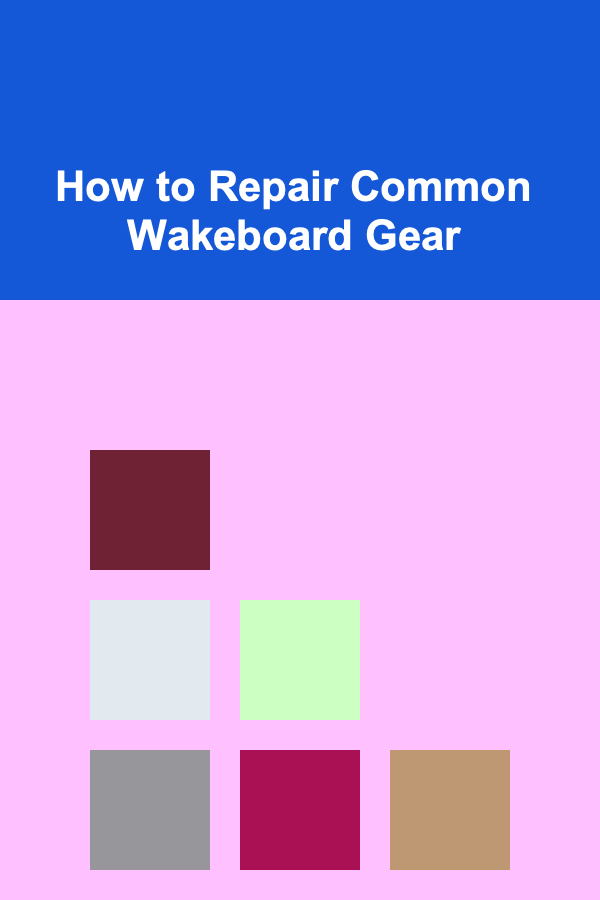
10 Tips for Working with Different Book Cloths
ebook include PDF & Audio bundle (Micro Guide)
$12.99$10.99
Limited Time Offer! Order within the next:

Bookbinding, as both an art and a craft, involves careful consideration of materials, particularly the type of book cloth used to cover a book. Book cloths are an essential part of bookbinding, providing not only aesthetic appeal but also durability and protection for the book's contents. Whether you're an experienced bookbinder or just getting started, understanding how to work with various book cloths can help you create beautiful, long-lasting books.
This article explores 10 essential tips for working with different book cloths, offering advice on choosing the right fabric, handling it effectively, and using it to achieve high-quality results.
Understand the Different Types of Book Cloths
Book cloths come in a variety of materials, each with its own set of characteristics. The most common types include:
- Paper-based Cloth: This is a popular option for bookbinding, offering a balance of strength and flexibility. It is often coated with a layer of adhesive to make it more durable. Paper-based book cloths are available in a wide range of colors and textures.
- Cotton Fabric: Known for its durability, cotton fabric is commonly used for premium book covers. It is often linen or canvas-based and can be printed or dyed in various colors. Cotton book cloths are ideal for books that will undergo frequent handling.
- Leather: While not technically a "cloth," leather is a traditional choice for bookbinding, offering a luxurious finish and exceptional durability. Leather book cloths can be quite expensive but are perfect for making heirloom-quality books.
- Synthetic Fabrics: These are more modern options, often used for their water-resistant properties and versatility. Vinyl and polyurethane book cloths can mimic the appearance of fabric while providing an alternative to natural fibers.
Each type of cloth has its unique advantages and disadvantages. Understanding these properties will help you select the best material for your project.
Choose the Right Weight for Your Project
Book cloths come in various weights, which will impact the overall durability and flexibility of the finished book. The weight you choose will depend on the type of book you're binding:
- Lightweight Cloths: Ideal for small or delicate books, lightweight cloths are easier to manipulate and can be more forgiving when it comes to handling folds and corners. These materials are perfect for projects like journals or smaller picture books.
- Heavyweight Cloths: Heavier cloths offer more protection and are often used for larger or more substantial books. They help ensure that the book will last for years without showing signs of wear.
When working with different weights, be aware of how the cloth will behave when stretched or manipulated. A lightweight cloth may wrinkle or lose shape more easily than a heavier one, which will hold its form better under pressure.
Test the Cloth for Adhesion and Flexibility
Before applying your book cloth to your project, it's essential to test how well it adheres to your book boards. Some fabrics may have coatings or finishes that make it more difficult for adhesives to bond effectively.
- Test Adhesion: Use a small scrap of the cloth and apply your adhesive to the back of it. Press it onto a piece of scrap board or paper. Allow it to dry completely before testing the bond strength. This will help you gauge whether the cloth is likely to lift or peel over time.
- Evaluate Flexibility: Different book cloths vary in flexibility, and some may not hold their shape as well around corners and edges. Test folding the cloth around a corner to see how it behaves. If the cloth starts to crack or peel, it might not be the best choice for your project.
Use the Right Adhesive
The adhesive you choose for your book cloth will directly impact the final product. Different adhesives have different strengths, drying times, and properties. Here are a few options:
- PVA (Polyvinyl Acetate): This is the most common adhesive used for bookbinding due to its strong bond and flexibility. It dries clear, which makes it ideal for use with any color of book cloth.
- Methyl Cellulose: Often used for more delicate fabrics or papers, methyl cellulose is reversible, making it ideal for archival work or repairs. It's a weaker adhesive than PVA but can be useful in certain situations.
- Cloth Glue: Some specialized adhesives are made specifically for bookcloth materials, providing a stronger bond that's more resistant to wear and tear. These adhesives often come in a tube or jar and can be applied directly to the cloth.
Ensure that the adhesive you choose is compatible with the cloth you're using. Always test it on a small area first to avoid any unexpected results.
Cut the Book Cloth Accurately
One of the most important aspects of working with book cloth is cutting it precisely. Clean, sharp edges will ensure a professional finish and reduce the likelihood of fraying or tearing.
- Use a Sharp Blade: Always use a fresh, sharp blade for cutting book cloth. A dull blade can tear or pull on the fibers, leaving uneven or ragged edges.
- Cut Larger Than Needed: It's better to cut slightly larger than needed and trim the edges later. This allows you to make adjustments as you go, especially when dealing with complex shapes or corners.
- Use a Ruler and a Straightedge: To ensure straight, accurate cuts, always use a ruler or straightedge. A metal ruler works best as it prevents any cutting mistakes that might arise from a plastic ruler shifting during the cut.
Properly Align the Cloth
When wrapping book cloth around the book board, proper alignment is critical for achieving a professional finish. Here are some tips for aligning book cloth:
- Use Guide Marks: Light pencil marks on the edges of the boards can act as a guide for positioning the cloth. Once the cloth is applied, these marks can be easily erased.
- Avoid Stretching: When applying book cloth, avoid stretching the material. Stretching can cause the cloth to become loose over time and lead to unwanted wrinkles. Allow the adhesive to bond first before making any final adjustments to the cloth.
- Use Even Pressure: Apply even pressure across the cloth as you smooth it out onto the board. This will help eliminate air bubbles and ensure the cloth adheres evenly.
Work with Corners and Edges Carefully
Corners and edges are often the most difficult part of a bookbinding project. They require precision and care to ensure that the cloth is neatly wrapped and adhered without unsightly gaps or wrinkles.
- Miter the Corners: For clean and sharp corners, miter the book cloth at a 45-degree angle. This helps to reduce bulk and prevents the cloth from bunching up at the corners.
- Use a Bone Folder: A bone folder is an essential tool for creasing and smoothing corners and edges. It helps to create precise folds and remove any excess adhesive or air pockets from under the cloth.
- Trim Excess Cloth: Once the cloth has been adhered to the edges and corners, trim off any excess cloth, leaving about ¼ inch of overlap. This will allow the cloth to wrap around the edges securely without excessive bulk.
Ensure Proper Drying Time
After applying book cloth, it's essential to allow the adhesive to dry fully before proceeding. Rushing the drying process can lead to bubbling, lifting, or wrinkles.
- Allow for Full Curing: Depending on the adhesive you use, the drying time may vary. Typically, PVA glue requires 24 hours to fully cure. Be patient, as rushing the drying process will only compromise the quality of the finish.
- Use Weights: To help ensure even adhesion and prevent warping, use bookbinding weights or heavy objects to keep pressure on the cloth as it dries.
Incorporate Decorative Techniques
Book cloth is not just functional---it can also be a decorative feature of your bookbinding. There are numerous ways to enhance the appearance of your book cloth:
- Foil Stamping: Use heat to apply metallic foil designs or text to your book cloth, adding a luxurious touch to your binding.
- Embossing: Embossing creates a raised texture on the cloth, adding visual interest and a tactile quality to the book's cover.
- Printed Fabrics: Choose book cloth that has been printed with unique designs or patterns. Printed cloths can be a great way to create a distinctive look for your book.
Experimenting with different decorative techniques can turn a simple book into a work of art.
Care and Maintenance of Book Cloth
Once your book is bound and the cloth is in place, maintaining its appearance is essential for longevity. Over time, book cloth can become worn, especially on high-use books.
- Keep Out of Direct Sunlight: UV light can cause colors to fade and materials to degrade over time. Store books in a cool, dry place away from direct sunlight.
- Use Protective Covers: If your book will be handled frequently, consider using a dust jacket or protective cover to preserve the cloth's condition.
- Clean Gently: If the cloth gets dirty, clean it with a soft, dry cloth. Avoid using water or harsh chemicals, as they can damage the fabric.
Conclusion
Working with different book cloths can be a rewarding experience, especially once you understand the nuances of each material. From selecting the right type of cloth to mastering the techniques for cutting, aligning, and adhering it, the process of binding a book requires patience, attention to detail, and a keen eye for design. By following the tips outlined above, you can work with book cloths confidently and create beautiful, durable books that stand the test of time.
Reading More From Our Other Websites
- [Home Storage Solution 101] How to Use Drawer Organizers to Simplify Your Home Storage
- [Weaving Tip 101] Seasonal Swatches: How to Choose the Right Yarn for Personalized Gifts
- [Organization Tip 101] How to Organize Rental Showings for Maximum Efficiency
- [Home Pet Care 101] How to Train Your Pet to Behave During Vet Visits
- [Personal Finance Management 101] How to Manage Student Loans When Your Income Fluctuates: Flexible Repayment Options Explored
- [Survival Kit 101] Backpacking Survival Kit: Essential Items for Safe and Successful Wilderness Trips
- [Home Staging 101] How to Use Neutral Colors to Create a Universally Appealing Home
- [Personal Finance Management 101] How to Master the Art of Delayed Gratification for Better Finances
- [Organization Tip 101] What Should You Consider When Organizing Your Movie Collection?
- [Organization Tip 101] How to Research Charities to Ensure They Are Legitimate

How to Make Money Online as an Online Tutor: 10 Actionable Ideas
Read More
How to Make Money Online as an Executive Assistant: 10 Actionable Ideas
Read More
How to Bake for a Crowd
Read More
Building AI for Future Technologies: A Deep Dive
Read More
How to Repair Common Wakeboard Gear
Read MoreDisability Insurance Expense Tracking for Freelancers and Self-Employed Individuals
Read MoreOther Products

How to Make Money Online as an Online Tutor: 10 Actionable Ideas
Read More
How to Make Money Online as an Executive Assistant: 10 Actionable Ideas
Read More
How to Bake for a Crowd
Read More
Building AI for Future Technologies: A Deep Dive
Read More